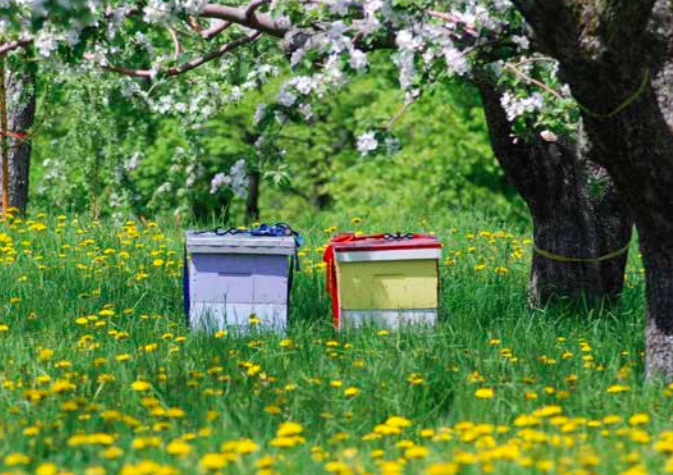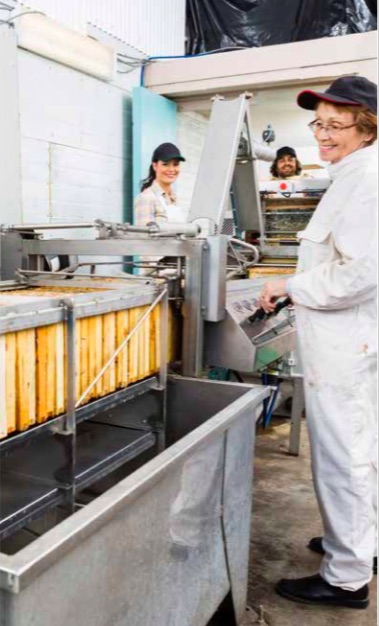
About the Apiary
An informative and sometimes humorous column published in
The New Zealand Beekeeper Journal
CONSIDERATION, CONTEMPLATION AND CLEANLINESS
About the Apiary - July - 2016Winter has arrived with lots of rain and the odd snowfall on the ranges. There is very little heat in the sun now, but the bees are able to fly for a few hours on still, clear days. The weather has been relatively mild for this time of the year. Pollen is coming in, indicating that brood production has started or is continuing in the hives.
Keeping the public happy
I have just been up north to celebrate a birthday and it’s very noticeable that there are far more beehives around and along the fence lines of major roads.
Yes, it might be easier to work them in these locations but apart from making these a target for thieves, there is also a health and safety aspect you should consider when placing hives close to roads, footpaths, and parks. Under the new regulations for the Health and Safety at Work Act, we are not to endanger the public in their normal activities.
Working bees in some situations (just before a storm, during robbing season) stirs them up and it can take a few hours for colonies to settle down again. The farmer, a road contractor or cyclists can be involved in a stinging incident through no fault of their own.
Some councils are now insisting that ‘all’ hives be placed 40 metres back from road boundaries following a few complaints from the public. As an industry we wouldn’t want to see this implemented countrywide as this could rob us of valuable sites, especially in the steep backcountry.
Consider the public and place hives out of sight from the roads, behind hedges or a suitable barrier so that the principle of ‘out of sight, out of mind’ prevails. It’s also healthier for the bees if they are placed in a sunny, warm, sheltered spot, close to a water supply. Perhaps we need to institute a code of ethics that includes best practices.
The hobbyist starting off faces the same predicament: ‘can I have a hive in the garden?’ Councils generally will allow you to keep bees provided they do not create a nuisance.
Check with your neighbours to see if they are allergic. Most people will say they are allergic as they swell with bee stings, but this is a normal reaction even if a whole limb swells. The person we have to be conscious of is the one that carries an epinephrine autoinjector (epipen) and needs adrenaline immediately after being stung. If this is the situation, then you will need to find another spot to locate hive(s).

Place hives in a sheltered, sunny spot in the garden at least four metres away from the boundary. Again, the general rule is ‘out of sight, out of mind’. Perhaps plant runner beans on a trellis to take the neighbours’ focus away from seeing the hive. If bees are forced to fly over people’s heads, they are far less likely to come into conflict with humans. Face the hive so the bees’ flight path is away from the neighbours’ washing lines. Provide a water supply for the bees—we don’t want them visiting a neighbour’s swimming pool. Put in a small pond with water lilies or hyacinth before the bees arrive before you take possession of a hive.
The only spot you may have could be on a balcony or carport roof. Supers of honey are heavy, but there are ways of managing this by putting frames of honey in nuc boxes and carrying these down safely.
Some of you might not be able to have your own hive, but you can still enjoy bees by planting a garden and teaming up with another beekeeper close by.
It takes about five years to learn to be a beekeeper. There are so many aspects to beekeeping that you never stop learning.
Managing a new beekeeping business
We are starting to hear stories (and I hope they are just stories) of new beekeepers expanding too quickly, getting in debt too deeply, having a bad production year and losing their main asset: their home. Banks won’t lend on something that is not permanent and beekeeping is a ‘risk occupation’ as far as they are concerned. Hives are there one minute and gone the next—all that is left are wooden boxes. It has taken years of negotiations for banks to lend on a percentage of honey in storage.
Some years you can do beekeeping by the numbers (do this on this date, and do that on that date), but often climatic conditions change from season to season and a lot of skill is required when things don’t go to plan. Any good beekeeping book or commercial beekeeper will tell you to hold at least a year’s income over for that bad year. When this happens we look for alternative sources of income: melt down old frames, scrap boxes for propolis, sell bees for export or even sell a few hives. Some may need a second job. In fact, it’s best to keep working while hive numbers are built up. You learn to work hives on weekends in the rain with an umbrella over the hive.
The skill in beekeeping comes with timing your peak hive population with the honey flow (when most of the sources are flowering and producing nectar). If you make a mistake and your bees are building on the flow rather than storing a surplus, or if you peak them too early, they swarm into the trees.
Some flows dribble in with not enough to cause the bees to draw wax foundation, so when honey boxes with drawn frames are put on, the bees chimney up the middle. Then there are a few flows we all remember when the bees filled everything with honey. In Canterbury they used to refer to ‘10 tonnes per 100 hive’ years, but these are no more with changes to agriculture and the introduction of dairying. In fact, I believe honey crops are reducing because of different farming techniques and overstocking of hives.
Look up the production statistics for a given area and halve these if you are starting out. Your most valuable asset is drawn comb and it can take a few seasons to accumulate enough for a good flow. In the meantime, your hives are using the honey they produce to draw comb or you can get comb drawn by feeding sugar syrup. However, you can’t do both in a season without the bees suffering or you getting pinged for having C4 sugars in your honey.
This is why most books will advise, if contemplating going into beekeeping, to work alongside another beekeeper for a couple of seasons, making and discussing the decisions on how hives are managed. A couple of seasons of ‘fetch and carry’ is good for the beekeeper but doesn’t improve your knowledge much, as you haven’t made the decisions and seen their consequences. Because we tend to manage apiaries as a whole, one mistake can reduce your production and put you back a year in your plan. That was the motivation behind my article in the May issue: make haste slowly (Lindsay, 2016 May).
Tips for a clean, safe honey plant
Most have finished extracting, cleaned up their plant and covered it so that it’s ready to be sanitised again just before it’s used next season. Use a bit of food-grade (approved) oil on chains and where frames run to reduce friction. Just before you start, use a blow torch to remove any spider webs under tanks and in tight corners. I was told by one Australian auditor that he always looked under tanks and equipment, as this tells the real story on cleanliness. Don’t just walk out the door after doing this, as you might have touched something that burns.
Fire is the one fear we all have with honey plants. Farmers lose barns to rats eating through wiring and birds nesting in tractors. Most of us use steam as it’s safer but in the honey house, moisture put into the air from the honey droplets or sticky hands during extraction can build up in 230-volt switches and sockets. Every couple of years, have an electrician check them and clean them with a solvent. I had one light switch I used extensively with wet hands fizz one year after turning it off. Plastic fittings burn within a couple of seconds when they short. I was lucky that I was still there when it happened.
Replace fuses with circuit breakers and ban multi-boxes. Most fires can be attributed to an overloaded multi-box. If you have to use a multi- box, make sure it’s fitted with a circuit breaker. The most you can put on it is one fan heater.

Vehicle maintenance
While the truck is not running, give it a complete check over. Check that all the nuts are tight and tyres are in good order. Change the oil, filters and fluids and bleed the breaks. Vacuum the seeds from the radiator and change the water. Fix those little things you put off because you were too busy during the season.
Carry chains at this time of the year. It doesn’t take much to get stuck and even snow chains can get you out of a sticky situation. Don’t be shy about asking for help when you are stuck. I tried for an hour to get myself out of a hole using chains, strops and tensioning everything with a fencing strainer. I had to give up and ask the farmer who had me out in a minute with his tractor and a chain. The odd pot of honey goes a long way to sweeten things.
Things to do this month
Sort out old combs and render them down. Purchase new frames. Purchase plastic frames early so the plastic smell has time to reduce. Waterblast dark plastic frames and re-wax. Make up new gear (bases, roofs, split boards, feeders, etc.) ahead of spring.
Check your hives after storms. Make sure cattle haven’t knocked any over. Heft each hive to check its weight. If there’s been robbing, check hives for varroa. Look around the grass for bees without wings or those that can’t fly—'crawling death'. If you are losing pollen-laden bees because they are landing short, add a board in front of the hives so they can crawl in. Keep the grass around hives short. Order spring queens.
Talk to your farmers and ask about planting willow stakes along the fence line close to your apiaries. There's lots of pussy willow around, so take two-metre-long cuttings from these. You should see the results in your hives in about four years’ time.
Winter is also a time to get a little education. Check the FarmSafe website for training opportunities.
Reference
Lindsay, F. (2016, May). Make haste slowly. The New Zealand BeeKeeper, 24(4), 38.
Frank Lindsay